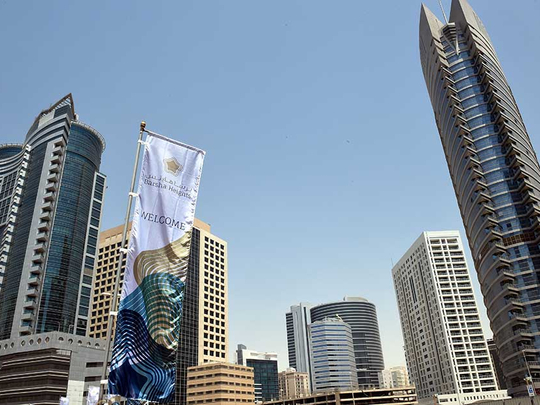
Dubai:
The clusters in Tecom (now known as Barsha Heights) and the funky Dubai Design District continue to be the top performing office clusters in Dubai, while there is a turnaround in the fortunes of JLT (Jumeirah Lake Towers) during the third quarter.
“After a sharp annual drop of more than 20 per cent, rents seem to have finally bottomed out while the lower rental range saw no change from Q2-16 to Q3-16,” says Core Savills in its latest report. “September and early October have seen a revival in interest from SMEs and commodity tenants with a bulk of activity concentrated in the 1,000-2,000 square feet bracket.” (The standout commercial properties in terms of occupancy levels are JBC, which could put “pressure on rentals due to their single ownership and perceived locational advantages”.) In comparison to the situation with Grade A offices in Abu Dhabi, Dubai’s veered from stable to seeing sharp gains in the recent quarter. It would also give a good deal of boost to developers who are currently converting their projects from residential into commercial and thus trying to plug a few gaps in office space availability.
Meanwhile, Tecom and D3 continue to standout in generating demand. The former continues to see occupancies “hover northwards of 90 per cent across most towers and we see strong demand, especially from existing technology and media occupiers looking to expand,” the report states. “This has led Huawei to purpose build its new national headquarters in Tecom.
And D3 has “bucked the overall trend of flat rentals and was able to lease out 85 per cent of its fi¬rst phase, now commanding 70 per cent higher rents than its opening lease rate last year. Due to its extremely high occupancies, it is now able to be selective in choosing fashion and design tenants. We expect a similar positive response to its next phase which is estimated to be delivered in 2019.”
In fact, such has been the impact of D3 in the collective real estate consciousness that its design ethos is inspiring other developers to create themed mixed-use clusters with a cutting-edge to how it is structured. A case in point is the upcoming launch by KAO, a new entity from Mohammad Bin Zaal, who was earlier involved with the upscale Al Barari community.
According to the Core Savills report, “Corporate tenants sometimes assume the commercial market will mirror residential market dynamics. However, the former is more complex, with each sub-market at different stages of the real estate cycle, influenced by a variety of drivers.
There are many submarkets — both free zones and onshore areas — that are following distinct dynamics and may be at a different stage of their individual real estate cycle. For example, areas such as DIFC, Tecom and D3 have been facing steady upward pressure on rents while other economic clusters are witnessing a varied range of rental drops over the last few quarters.”
Elsewhere in the city, the Downtown offices have been able to maintain headline rentals while those such as Emaar Square and Boulevard Plaza saw a 5 per cent increase in their upper rental range due to high occupancy levels.
“Requirements range between 3,000-4,000 square foot and are generally larger than those witnessed in the surrounding districts of Shaikh Zayed Road and Business Bay,” the report notes. “As HSBC is scheduled to move into its purpose built facility by the end of 2017, we expect its current offi¬ce in Emaar Square to also come to market, adding the only near term stock to the district.”
New pipeline should keep office rentals in line
* New developments around Shaikh Zayed Road and Business Bay is leading the supply pipeline and expected to keep rental rates under pressure. Business Bay continues to see increased enquiries from small to mid-size occupiers, especially from start-ups and SMEs and was able to maintain its average rentals throughout Q3-2016, according to Core Savills.
Locations such as Bur Dubai, Deira and Garhoud experienced limited movement in activity levels from their captive market, keeping the rents relatively at across most buildings.
Meanwhile, smaller offices in DIFC command a 15-20 per cent higher rent due to a lack of availability of similar unit sizes.











